Roberto Ugolini bespoke boots: Review
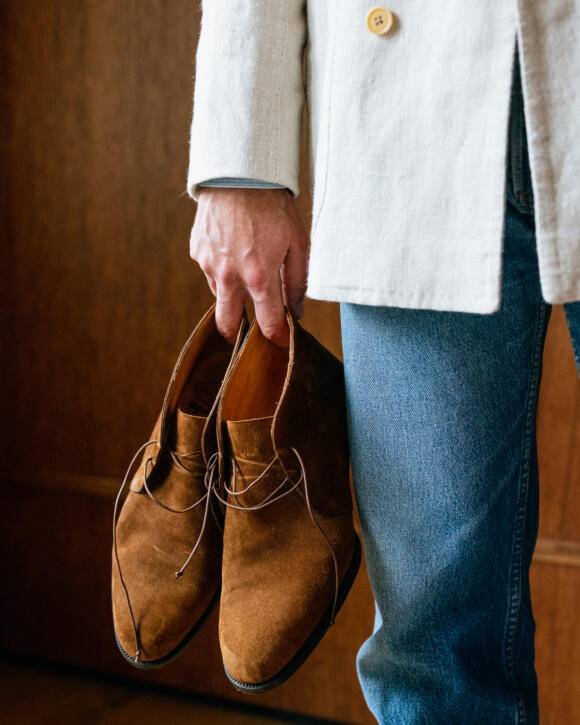
I recently had these boots made bespoke by Roberto Ugolini in Florence, and they have turned out very well. I have two reflections about bespoke shoes off the back of them.
One is that I am increasingly specific about what I need in terms of fit, and it seems to be paying off.
I make it very clear that I only get pain with shoes in two places. One is the outer edges of my toes (little toe joint, little toe itself, fourth toe) and therefore I need width in that area. It’s what kills me on narrow shoes like my old Corthays and, more significantly, bespoke shoes in the past.
The other area is the top of my big toe, which is rather larger and taller than the others. Any shoe that is too tight across the top will bite on that big toe and be horrible.
Beyond that, I’m golden. There are many other areas a shoemaker has to get right of course, but these are less crucial. It’s in those two areas that makers have fallen down over the years.
When I talked to Roberto, I made this clear. At the measurement stage, at the fitting stage, I swallowed that natural English reticence and communicated rather specifically.
When I was younger I didn’t, and a lot of those shoes were just too small for me. Partly it was awe at the bespoke process itself - the work these makers were going to do on my behalf, the combination of skill and strength. But just as importantly, I didn’t have confidence in my own opinions.
The shoes felt tight, sure, but wasn’t that how it was meant to be? Even when the results were sometimes painful, they were not that much more so than ready-to-wear could be - just in different places.
During the pop-up in London recently, I had two separate conversations along the same lines - readers saying they’d tried bespoke and it wasn’t what they expected, but they weren’t confident of their opinion.
My lesson is not that everyone should speak their mind and shoemakers should obey them. (I’ve heard enough odd opinions to sway away from that.) But instead, that it takes time to know what you need.
I should have learnt faster, certainly, but I think everyone needs time. No one comes to this with any experience, and we don’t have friends or family that have been through it either, as in older generations. Shoemakers themselves might also benefit from talking about this to customers.
And it adds to the argument I made last year, that bespoke shoes really make sense as a long-term thing - over years and pairs, often with the same shoemaker. I have to cover everyone; I wouldn’t necessarily recommend anyone else do the same.
In fact it almost feels unfair to compare this Ugolini experience to those older ones with other makers, given how much I’ve changed.
But that shouldn’t take away from how nice the boots are. I was particularly pleased because I’d heard a couple of negative experiences from acquaintances, but mine were good at the trial stage, were well executed, and the style was exactly what I was expecting.
That last point is my second takeaway: whenever possible, commission shoes that you have already seen in person.
Roberto has a decent range of shoes and boots on display in Florence, and I picked a specific chukka, then picked the suede to make them in (from an actual hide, pleasingly). I knew what to expect, and so it was much more likely the result would meet my expectations.
When I look back on bespoke shoes in the past, I so wish I had done that more.
My Cleverley double-monks, for example, were a real mismatch of shape and style - too elongated and fine for that leather and style. We did talk about making the shoe rounder and more casual than the previous pair, but the salesman and I were clearly talking about different things, because the changes were very small.
You’d think I’d be more relaxed these days about making mistakes with such commissions, given I have a fair few bespoke clothes. But it actually annoys me more, feels more frustrating. Perhaps it’s the waste; perhaps the thought that I should know better.
The one thing I was a little unsure of with the final boots was the sole edge - which tellingly, is the one thing I changed from the pair on display.
I went for a dark colour, and a lighter one would have been a more natural fit for the snuff suede. But I’ve found the difference small, and it means the shoes are slightly easier to wear with things like dark denim.
I’ve also found the boots a nice match for anything that has a slight Western feel, as this clothing combination does (full details on that here). The shoe has that slightly pointed almond shape that we discussed on this original piece on my roper boots.
Elsewhere, there are small points where you could point out that the finishing is not quite the same as the very top bespoke, such as along the welt line. The work overall is good though, and the price also lower than many makers, with shoes starting at €2300 and these boots costing €2400 (both excluding VAT). The couple of scratches on the upper are also my fault - or rather, natural signs of wear.
The boots have beautifully made boot trees (that's the handles showing out of the top), a box made with local Florentine paper, and I rather like the way the laces are finished with simple knots. Those things are probably in descending order of importance.
Overall I’m very pleased but also slightly relieved - relieved that the boots fit well and I will wear them for many years to come. Hopefully I’m getting better at commissioning them, even if it’s taken a while.
(Oh and this experience probably weighs against the idea of making shoes based on scans of the foot, at least for bespoke. The challenge of bespoke is not knowing what the customer’s foot looks like.)
Roberto currently travels to New York, Seoul and Japan for trunk shows.


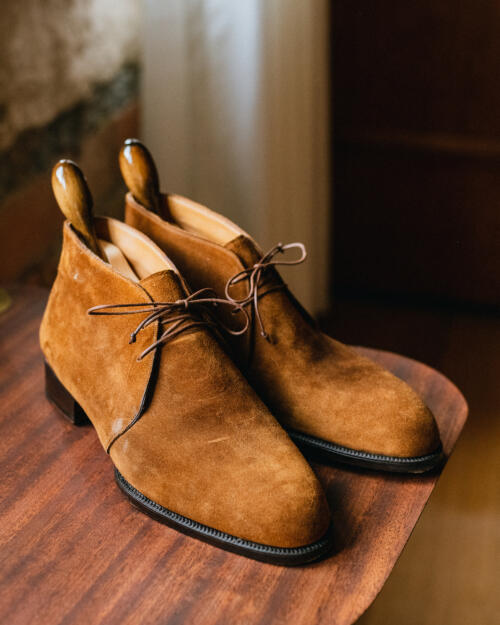
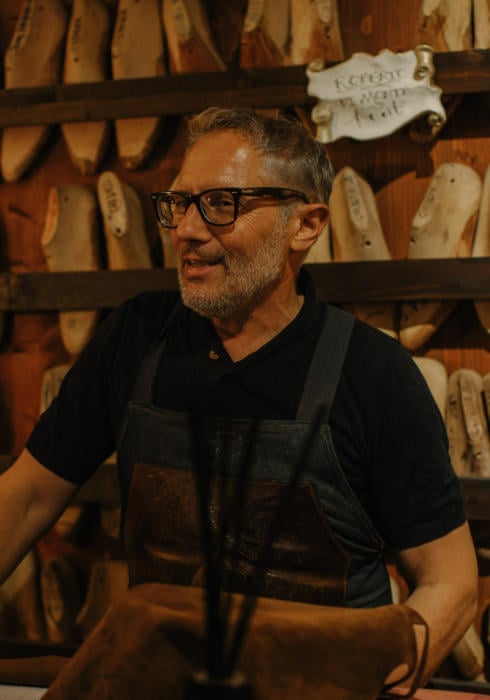
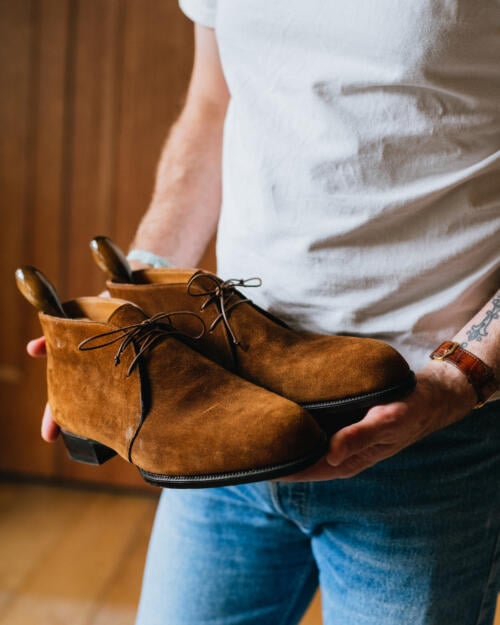
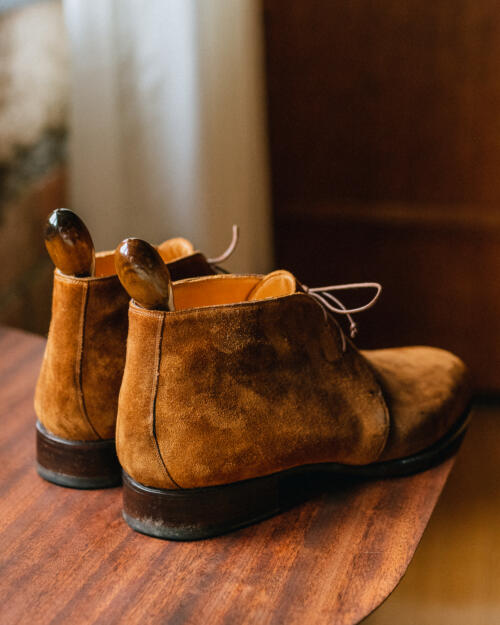
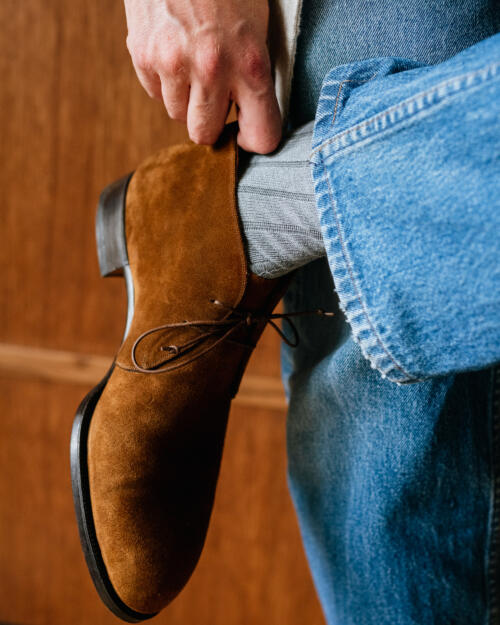
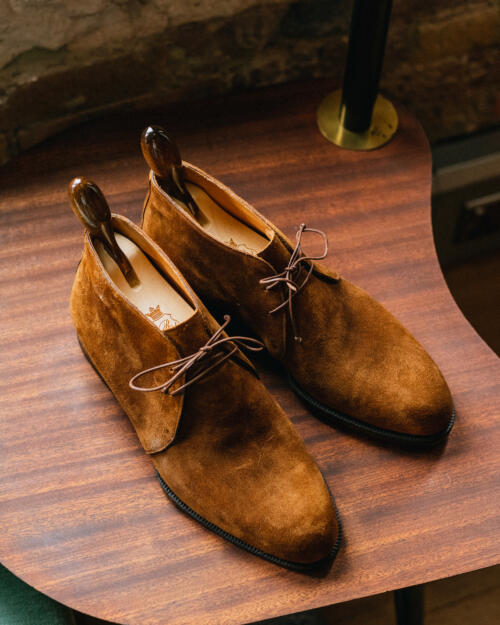
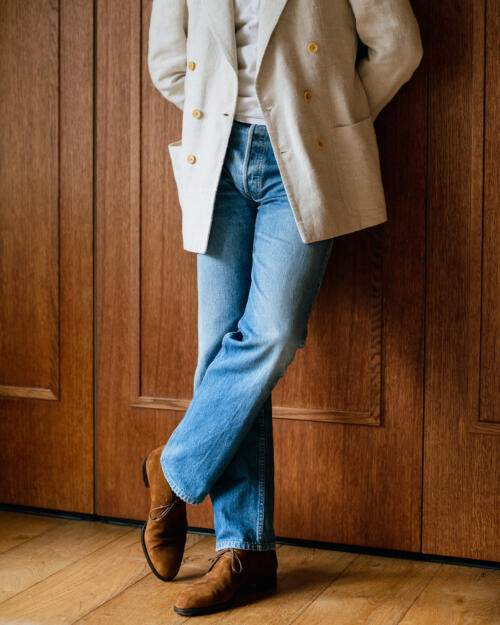


























Very interesting Simon – my only one thing which has always scared myself is I have fully collapsed arches. The closest experience I have had many, many years ago are ski boots through scans which were a bit of a disaster (pushing my arches up to compensate was a bad idea because my body has adapted). Basically I still don’t really understanding my own feet and maybe I need to firstly be more aware of my pain areas with RTW.
One question – is there a specific style/type of shoe that is a good starting point (maybe for forgiving?) for bespoke?
Generally a shoe that has more room for adjustment through lacing is easier, like a derby, but if you’re that unsure then I wouldn’t really recommend bespoke – certainly until you have a better understanding through RTW as you mention
Besides going for a derby, I’d recommend to start with suede or any other softer leather before going to stiffer leathers like Cordovan.
Not a bespoke shoe customer yet (also not a doctor!) but as someone with collapsed arches who’s spent the last year addressing my foot pain, I feel that a podiatrist and massage therapist should be your first stop — if you had one before, it sounds like maybe a second opinion would be helpful as you say you haven’t figured out your pain areas.
If they recommend orthotics beyond your budget there are good stock options for insoles (https://yoursole.com/ is my go-to) that are much cheaper than orthotics (at least in Canada) and for most people will do the job unless you have very unique feet. Some approaches to podiatry just involve putting anyone in orthotics, of course people in the barefoot/minimalist footwear circles have their own thoughts on that, but truly flat feet are not really “cure-able”, so from what I understand proper support is important for going about your day.
From there, you can start to understand what you need in support and then you can incorporate that into your shoe purchases (right now I’m just buying sneakers and RTW leather shoes), but I think building up that knowledge about yourself first is going to make your footwear purchases at any level much better. As Simon said, a better understanding is the key. I don’t think a leather or lacing pattern or even a new Brannock measurement is going to be the difference between you having foot pain or not if you don’t yet know where your pain areas are and what kind of support you need. Hope that helps!
I’m a fellow collapsed arch person — I imagine I’m in the 98 percentile of collapse-ness haha. So I wanted to ask — what do you mean by: “(pushing my arches up to compensate was a bad idea because my body has adapted).” Did your ski boots make it more challenging to transition back into other footwear?
Lovely post Simon.
I have my MTM Regent Oxford style shoes from G&G now for coming up on 1 year and it seems to me that they are still “ moulding around my feet” and breaking in beautifully.
They were tight to begin with, I had them stretched which I didn’t like getting done, but I think that it’s a case of patience pays off here. They even fit better with slightly thicker guage dress socks…Manzarin and Bresciani.
They are worn once to twice each week.
What’s your experience Simon in this respect?
In terms of moulding of RTW shoes over time? That certainly happens, but it’s fairly minor. I’d characterise it as improving the fit of an already well-fitting shoe, rather than changing the fit substantially from what you try on, if that makes sense. Which is perhaps why you needed yours stretched after a while
Thanks again
Lindsay
All three of my G&G MTM shoes have had to be stretched. They’re always too tight – a perennial disappointment. The staff there just don’t listen. I’ve recently switched to full bespoke with Yohei and hope the result will be better.
Did you realise anything along the course of the three Philip?
not Philip but I have realised smart captoes are just not for me. (wide flat feet). last 4 rtw pairs from different makers quite literally bled joint of my left toe on top. and I’m not sure it’s sizing that matters.. 1 pair was borderline unwearably small, 1 pair borderline unwearably big, and 2 decent fit.
I just need to plaster up and tolerate it until captoe stiffener creases. strangely plain toe and wingtip same maker same last I often have no issues.
one pair 20-30 wears later didn’t improve so it’s on eBay…
one very silly tip but works amazingly for me is to wet the spot on the sock where shoe is uncomfortable and than wear it as normal. doesn’t work on heels but on pinky and toe joint shortens break in time by about half.
p.s. I don’t have any shoes over 600£, most of my shoes is 200-300£ so use it on your own risk.
It’s precisely as you say, Simon. The tradesmen generally know best, but not always. They may insist that I don’t need that extra couple of mm in my little toe. But after 20+ years of wearing dress shoes to work I know that it makes all the difference between enjoying them or dreading them. I had a similar issue with my shirts at T&A, where they simply refused to make the collar wider. Now of course I can never stand to wear a tie with those shirts. Your article really resonated with me in that respect.
I have bought MTM shoes and boots from both Yohei (chukkas) and G&G (derbies) and they both had to be stretched; that being said, I think I’ve finally broken in my G&G but I’ll admit it’s been a somewhat painful process! I’ve found that in both cases it was one foot that was uncomfortable whilst the other was perfectly fine.
It’s extraordinary that Philip and Clav have needed to stretch their MTM shoes. There is no excuse for them being painful or uncomfortable to wear. For the price, the fit of the finished shoes should be spot-on. Personally, I would not accept ill-fitting MTM or bespoke shoes.
It’s also very concerning that G&G’s staff didn’t listen to their customer on such a vital issue. It would interesting to know if other customers have had similar problems with G&G or other makers. It would certainly make me think twice about moving up from C&J’s RTW ranges which fit very well and don’t need breaking in.
My problems at G&G date back to 2016. My original pair of MTO shoes are borderline unwearable to this day despite multiple stretches. I had expressed concerns about the fit at the time but was told that the tighter fit would be far more comfortable over time, which hasn’t turned out to be true. I was told by staff in later years that the original fitter (since departed) “liked a condom”, which didn’t make me happier. I persisted with them, and my subsequent two pairs were progressively less problematic, but they’re still uncomfortable. I’m annoyed by that because I’d asked for extra room in my third pair but received pushback and simply gave in. As Simon says in his article, I should have known better. I might wear one of those later pairs once or twice a month, and then only reluctantly – the rest of the time I reach for RTW.
Great observations on the process of ordering bespoke shoes. I’ve had very painful experiences with two pairs from one maker, in large part because I wasn’t clear and loud enough about what hurts. Then I’ve found another maker and he managed to get the fit 95% right on the first try, again – partly because I was much better at communicating what the problem areas were.
Sadly, he then proceeded to move from Warsaw to San Francisco 🙁
Nice boots.
How would you compare the construction and finishing quality compared to your Saint Crispin’s chukkas?
Thanks.
The construction is not as solid as the Saint Crispin’s – those are quite tough in their make, and take a bit of time to break in as a result. I’d say these are more standard. The finishing is similar, perhaps slightly better around the edges on the StC
Thanks Simon,
I love your honest about the cost, process and result. I know it is what you do but so many operate on a form of patronage.
I have stuck pretty religiously to Church’s and Cheaneys over the years. Not having any noticeable issues with my feet nor shoes if I stick to 45 Euro or 10 1/2 £sd.
This and previous articles you have done on bespoke shoes, seem to reinforce that the cost benefit / investment purchase applicable to suits and Jackets does not hold with footwear.
This opinion is of course only monetary, if you we all only ever stuck to sartorial decision-making on fiscal prudence, it would be a very drab world.
Cheaney’s fit is a bit too narrow for me. I have stayed loyal to Crockett & Jones over the years. I recently stopped using Tricker’s because the quality has dropped significantly, especially the leather soles. It’s no coincidence that Tricker’s seems to spend a lot of time on inferior collaborations with fashion brands and retailers.
What’s the rule regarding remakes for bespoke shoes? If you weren’t happy with your Cleverleys and it was a matter of their misunderstand you, why not request a remake?
If they’d made an obvious error – eg I asked for a cap toe and they made a wing tip – then absolutely, they should have remade it. But it’s much harder when it’s a matter of communication – I asked for it to be rounder, and it was very slightly rounder, rather than completely different. It’s why it’s so much better being able to point to a style, in the same way you buy RTW.
Also, it goes to the point of inexperience and lack of certainty at that point. I didn’t really have the confidence to say this wasn’t what I wanted, and to talk through what could be done (eg maybe a discount on a future pair or some other kind of compromise – at least to have a conversation about it)
“You’d think I’d be more relaxed these days about making mistakes with such commissions, given I have a fair few bespoke clothes. But it actually annoys me more, feels more frustrating. Perhaps it’s the waste; perhaps the thought that I should know better.”
I’m interested in this line of thinking. From my own history in commissioning clothes, I now have pieces that are of great quality and should satisfy 99.9% of the populace, yet frustrate me for the thought of what I’d now do differently had I commissioned them today. Often it’s something as minor as a quarter inch of length or a certain style of pocket. A different topic from today’s, but how do you still value or enjoy clothing with that “I’d have done this differently” thought in your head.?
I think it depends a lot on the scale. If it’s minor things like the ones you mention there Eric, I think you have you live with them and even love them for their eccentricities. Because nothing’s perfect and at some point in the future even a perfect commission will become not perfect because, for example, you change physique or it gets a little rip that needs repairing.
But that’s different to something major like selecting the wrong cloth, or the right cloth in a far too structured make, because that affects the style of the piece in a much bigger way.
Hi Simon, I know you’ve done similar articles but I would love to read more into this topic if you find yourself looking for ideas!
It would also be great to hear about it from the guest writers as well — I’m loving the diversity of viewpoints on the blog lately. Credit to you for curating a circle of people with quality insights.
Thanks, and really nice to hear!
Thanks Simon – lots of helpful info on bespoke processes and bespoke boots. Regarding the height of any boots (chukka, chelsea, etc…), do you have any rule when discussing how high you want your boots to be? For example, chelsea boots come in different heights, ranging from 14cm to 20cm. I asked my bespoke chelsea to be 18cm, but without any particular reason.
I don’t think I’ve ever used a number, no, I’ve just visually looked at what has the right balance, and always err on the side of what feels the most classic and subtle
By the way Alex, I see you submitted this comment more than once. Keep in mind I might not get to publishing and replying to a comment for a while (eg I’ve bene at Fox Brothers in Somerset most of today). Cheers
Thanks Simon, and apologies about my posts! I think there must’ve been a glitch or loss of connection, leading to several posts – please disregard the others.
Do you think boots could start affecting the fit of trousers if they’re too high?
No worries.
No, unless the boots are particularly large around the top, or your trousers are particularly slim. Sometimes if the trousers are shorter too, they can get caught on the top of the boot, but again usually if they’re fairly large at the top (or there is a pull tab on the back)
Thanks Simon.
Really love the style and shape of the boot. I’m a big fan of Chukkas and you’ve done a great one with these. May I ask if the soles are leather or rubber? From the Photos I would think they have a rubber sole!
Thanks as always Simon for your great work!
Cheers Amon. No they’re leather
I understand trying to deal with discomfort longer than you should. It took me too long, and too many pairs of shoes, to accept that my feet had certain problem spots and that I simply could not wear shoes that aggravated it. For me it’s the bottom of my right foot, in the arch by the heel. Certain footbeds / heel shapes (I’m honestly not entirely sure) just make it feel like I’m standing on a marble under my arch. Trying on a pair I would only have mild discomfort, but over the course of the day it would just get worse. Some pairs were worse than other; one in particular would get to be so painful I had to walk on my toes by the end of the day.
For some reason though, I’d still try on a pair, notice that discomfort, and think “well maybe this pair won’t be so bad”, and I have a bunch of shoes I no longer wear as a result. These were entry level nice shoes, so thankfully I’m not out all too much money from this, but I’ve learned my lesson.
Sorry to hear that Michael, that sounds painful
Suede is normally more forgiving than regular calf leather. Desert boots are very comfy and these look similar.
A more rigorous test would be a plain leather Oxford.
Normal desert boots are comfy because they’re often unlined, have crepe or rubber soles etc. These are neither, they’re made like a regular dress shoe.
Suede is usually more forgiving, yes, but mostly over time. I’ve had suede shoes that have been just as painful as calf.
That was a nice read. It’s good to see that even though it was about your new boots, it really pushed the importance of understanding your own needs and communicating that with makers. It really helps us.
Coming from a makers point of view (shirting and tailoring background), I find customers who come with a clear idea of what they want i.e. style, fit, fabric etc are the ones that leave happiest as have worked to a level of expectations. They also become good repeat customers and recommend you to others.
The opposite end of the spectrum are customers that romanticise the idea of having something made without having a clear idea of what they want. They go either over the top by the possibilities (once made shirts that had extreme cutaway collars, epaulettes, two chest pockets and double cuffs!.) or don’t know what they want but want to have something made. This is when every question asked is answered with a question of what do we think or recommend, you either get a customer who is exceptionally happy or underwhelmed and picking out problems.
Back to the boots, I much prefer the darker sole as it helps make the colour of the suede pop and lighter coloured soles have been sullied by cheap high street shoe shops.
Nice to have the perspective of a maker, cheers Charles. And pleased you like the sole edge!
Hello Simon,
Thank you for another interesting read. I have not had a pair of bespoke shoes made as of yet, but plan to. One thing I am unsure about is how an orthotic interfaces with bespoke shoes (I wear custom orthotics in all my shoes due to having less than perfect feet!). Does the shoemaker build an orthotic into the shoe interior or do they make a shoe that would enable the wearing of an orthotic?
It’s not something I can speak directly about, as I’ve never had it done. But usually the maker prefers to deal with the issues themselves rather than use an orthotic.
It might be harder for you to get bespoke right though, both because you have unusual feet and because you’re used to a very particular fit with your orthotics
Bruno – I wear orthotics in RTW shoes (they support my arches and stop pronation). Both Cleverley and G&G have successfully incorporated the shape of the orthotic into my last so that the orthotic isn’t needed.
It was one of the reasons I went bespoke – although the orthotic fixed the pronation problem, it raised my heel and meant it was very difficult to get RTW shoes that fit. Have never regretted going bespoke.
Interesting article – especially as you chose a Chukka Boot, rather than a more formal choice. I agree 100% on the vision vs. what you should actually ask for aspect. I used to see a super helpful lady at Peal in Brooks Brothers in New York for years, and then Alden for the same (width) reason… Thank you!
Hi Simon,
Do you prefer these bespoke chukkas or your St Crispins?
How is this make compared to a high end RTW like Edward Green?
Thanks.
I prefer these a little because the fit was great from the first, but the styles are also a little different
The make is of course better than EG in lots of ways because they’re bespoke and so handmade
I struggle a little to understand why one would spend so much money on something that is uncomfortable to wear, and which offers so little room for adjustment.
Unless you have particularly difficult feet, it makes sense to find a last that offers equivalent comfort and pay a quarter of the price.
Perhaps worth having a look at the ‘Are bespoke shoes worth it?‘ article Anthony. At the very least, bespoke and RTW are made very differently.
Thank you Simon.
I read that article when you originally posted it, and I think my argument remains wholly valid.
They may be made differently,. but that in itself is not a solid argument for paying four times as much for something that doesn’t necessarily offer much more in the way of comfort, is it?
When you’re half way through your day and your feet hurt, you will not be consoled by reminding yourself that your shoes were made by hand.
No, it’s not enough justification on its own, but being handmade is not the only factor, and comfort is not the only factor in buying a pair of shoes. Plus, there’s no reason a bespoke shoe would be less comfortable.
It’s not a simple comparison and I’m afraid reducing it to one factor or an assumption about the two shoes being compared isn’t that helpful.
Simon I think you are missing my point.
A lot of comments here reflect disappointment that MTM shoes have ended up being pretty uncomfortable. I therefore expressed my view that it seemed pointless paying so much to be uncomfortable when you could be equally uncomfortable for a lot less money.
Sorry if that was not clear enough.
No worries. Yes, I understand that point, I just think it’s generalising too much. It’s not many experiences, so comfort isn’t necessarily worse, and if the comfort is the same in two pairs, as I said, there might well be other things you would value
Hi Simon,
I bought minimalist trainers about 2,5 years back to wear for working out and walking, as we have a lovely store for those types of shoes here in town. Wearing these shoes extensively over a period of about 5 weeks that summer, I could not go back to wearing any of my dress shoes, as my feet had grown. Apparently, I had always worn shoes that were way to narrow for my short, wide feet with high instep. I went to a cobbler in town and had my feet measured and concluded that they are at least H width. Imagine my surprise learning this at 40 years old. I tried wearing a pair of Carmina jodphurs on a trip to Paris, but my feet hurt so bad I could hardly take it. Like the feet had learned how shoes should fit.
Luckily I found the guys at the Last shoemaker, who seems to be the only maker that makes shoes adapted to ones feet, rather than the other way around. Reading all the comments here it seems this is a widespread issue, that makers simply stick to a tradition of making shoes that are actually hurtful to the feet. I ordered my first pair of black oxfords from them, there was no breaking in period, there is no pain at all and these arent even bespoke. My next pair is bespoke and in the making. I cant see myself going back to wearing shoes that may look good but hurt my foot to some extent. At least for those of us with very wide feet, the styles of popular high-end makers are rarely an option.
My question is, why is this a larger topic for discussion? Surely comfort must come before design when it comes to shoes, as the state of the foot effect the entire body. I have walked with a slight limp most of my adult life, which is now gone, simple because my shoes are no longer squishing my foot.
I’m not sure I would necessarily reach that conclusion from this piece Nicolas – we’re talking about bespoke here, and many people can wear RTW dress shoes and be perfectly comfortable, even if that isn’t the case for you.
The point about comfort v design is also not a simple one. We nearly all make some choice towards design deliberately in all of our clothes, and don’t just prioritise comfort. And it’s often about balance – taking advantage of the freedom today to wear beautiful dress shoes one day in town, trainers the other day working at home.
I agree with you for the most part on this. Thing is, I wonder if most men are accepting lesser comfort than they can have in their shoes. I, for one, was unaware of how badly my shoes where adapted to my feet for all these years, simply because there is little discussion on this out there. I learned most I know about shoes from reading your posts and Shoegazing, and I think only of late have you also started talking more about fit and comfort in more detail (I may have missed something in the past though). Maybe we get wiser on these things as we get older. Anyways, problem is solved for me, so just my ten cents.
No it’s really useful Nicolas. I think we should have it out there, but not generalise too much about what all men’s experiences are like, if that makes sense. It’s a valuable contribution to that discussion
Just checked out The Last Shoemaker and I’m pretty impressed at least design-wise — I’m looking into Vivobarefoot for my next pair of gym shoes but otherwise have had a really hard time finding minimalist shoes I’d want to wear day-to-day. A lot of brands look like they’ve been made in someone’s backyard. And even with minimalist cushioning and a wide toebox I still need arch support and possibly a heel, and a lot of minimalist footwear community is very averse to those things. Will be looking into these for sure, the closest thing I’ve seen otherwise in a good dress shoemaker is Stefano Bemer’s A-Last. Full disclosure that I haven’t yet tried any of these makers so my opinions probably aren’t really warranted but this stuff is really important to me as I venture further into this area
I’ve noticed most pictures of stylish people wearing snuff suede shoes don’t include a belt or at least don’t show the belt. I think this is because a belt in that light of a tone often looks quite jarring in combination with light shoes. I somehow like the snuff suede tone on my shoe but not the belt and therefore I am often a little lost on how to wear the shoes with an outfit that requires a belt. Can I get away with my usual darker brown belt? Any advice for me?
I wouldn’t wear a darker brown belt, no. Perhaps a shade darker but not a real dark brown.
If you have to wear a belt there isn’t really a great option – except maybe something rather different like a canvas or webbing belt with some tan leather at the front, or just the canvas on its own in a colour like cream/natural than is the same kind of tone therefore as the shoes.
I have a few of those elastic braided belts (relatively well made and nice enough hardware, there are lots of lesser examples on the market) and one of them is a braid of mustard/light brown, beige, navy and darker brown and that works really well in my opinion with lighter coloured suede shoes, like snuff chukkas or beige loafers. The colour combination is actually quite subtle and it picks up on the colour of the shoes without being to bright and/or matchy. Only with jeans or casual chinos though, nothing smart.
Hey Simon,
Lovely shoe. Particularly like that color complementing the St Crispins in dark brown suede.
I’m looking for a boot equivalent of a loafer with a nod to Ivy style. Something with the style of a chukka without the laces. Chelseas are a bit too mod for me. The LP Open Walks are a bit too much of a meme/flex but I saw Aleks post about the C&J Kempton 3. They have a brown suede version which gives off laceless chukka vibes and it’s from their hand grade collection. JFitzpatrick also released a laceless chukka but that feels more like a response to the Open Walk than an actual unique shoe like the Kempton. Do you have any other recommendations for a laceless boot that gives off a chukka feel?
Hey Adam,
The Kempton 3 is cool, but I think it’s a slightly different style without the laces, and in fact any chukka without the laces might get away from the Ivy style you’re after potentially.
Are you that opposed to laces? A simple Alden chukka would seem to fit you well
Oh just laziness. I have young kids so shoes I can easily pop on like loafers are super helpful in the fall/winter. Chelseas were also on my mind for that reason. I like the look of a chukka like the St Crispin but there are the laces
I think it’s probably worth the extra couple of seconds, rather than compromising the style you’re after in such an expensive shoe. Speaking as one that’s raised three so far!
The suede boots described is the perfect all rounder in my opinion. It works with casual attire to semi formal and works in the city as well as the country. The only thing I’d change is I would go for a chocolate suede instead.
I am a physician, with no personal experience of bespoke, but I have had many patients who have had shoes made for them, because of deformity, by what used to be called an orthopaedic boot maker. These are, I presume, bespoke, but utilitarian. My point is that this was only about fit, and shouldn’t the primary reason for bespoke shoes be about fit? I am interested in what Simon thinks on this.
Hi Patrick,
I’m not sure why the primary reason for bespoke shoes should be fit? It’s certainly a big factor, but at the same time a customer may have RTW and bespoke that fit as well as each other – the bespoke no better – and still really value the bespoke for: the unique look; the craftsmanship; the longevity; the ease of repair; the personalisation.
Interesting. How would shoemakers typically cater to individuals who use orthotic inserts to offset pronation or supination? I imagine designing the shoe to accommodate an insert would be simpler than crafting a correction into the shoe.
With a made to order shoe, perhaps it might be easier, but with bespoke the point is trying to cater to everything the foot needs in terms of support, so most bespoke shoemakers would be trying to do this in the way they made the shoe anyway
Hi Simon
Isn’t suede a problem in rainy London? How do you care for suede?
Debra
Not that much, no, though a little harder in lighter colours. We covered this in detail on this article Debra when it comes to dealing with rain.
And then this article on how to cope with damage when it happens.
Simon,
Love the boots, but can I ask about the jeans in the images? Where are they from? Like the boots, they’re a lovely shade.
With regard to a casual chukka boot, how would you compare such a snuff suede to a waxed suede?
Thanks
Sure Graham, they’re 90s Levi’s, bought on eBay – something we covered here.
A waxed suede might be similarly casual but is always going to feel rougher, more rugged. I probably wouldn’t wear it with a tailored jacket like this
on the bottom photo your very nice double breasted jacket is open. I love this look. I think women wear it particularly well. But all the ones I find are so structured for buttoning up (normally vintage jackets sold as separates for me) that they look wacky or drunk. I remember you recently had these made but can’t find the article. Did you specifically cut it in a way for this effect?
The jacket was covered here. Looking good like that unbuttoned is mostly about a soft make, so you want a Neapolitan or at least Italian make probably
Hey Simon – do you think their other offerings (beyond boots) are also good?
I’m sure the make is just as good on the other types of footwear, if that’s what you mean. But a lot of the designs and shapes are too showy for me
Thank you, great read! Are there any rtw loafers that fulfill those requirements that you can still wear? I also have problems with my big toe and for example can’t make B&L work for me.
Hi Marc,
Yes I wear lots of loafers, and over time have drifted towards bigger sizes so that the front is comfortable, even if the back slips a bit. It’s not ideal, and you still want to pick between different lasts/shapes, but that’s how I make it work. Also tongue pads help with the heel slippage
Much better to use heel grips than tongue pads on loafers.
Thanks Harry. I’ve tried both and find tongue pads more effective
Fair enough. I’ve also tried both and find heel grips work better!
Great choice. I love the curve of the quarters (and tend to dislike angular ones).
Gosh, sounds like your past experiences have been terrible.
Surely the bespoke makers should know their trade well enough to make shoes in the style that works with the leather and definitely should not be painful once made.
I just read that a lot of RTW boot manufacturers use the same lasts as each other.
Are there some common lasts to know of?
I’m not sure that’s really true Joel, at least among the ones we cover, eg from Northampton.
Hi Simon,
I should have said USA manufacturers of “heritage” boots.
Ah, ok, thanks Joel. Not a market I know that well
Hi Simon – is there an email for Ugolini, could not find a web site, will be visiting Florence soon and would like to book an appointment.
Thx
I always talk to him through Instagram, Michael
It would be great to have a post on shoe sizing between countries?
There’s a pair of Japanese boots I like that most likely I will have to get from The US.
The shop asked me to get my feet measured using a Brannock sizer.
I actually ended going to a Clark’s shop to get measured and was told I’m 8.5 G. I thought G width was a wide foot, however, I believe Clark’s have their own sizing and G width is their regular width.
Sizing can be quite complicated from one country to the next and from one brand to another, hence the request.
Simon, in reading this article, I’m not sure I understand this comment: “(Oh and this experience probably weighs against the idea of making shoes based on scans of the foot, at least for bespoke. The challenge of bespoke is not knowing what the customer’s foot looks like.)”
If the challenge of bespoke is not knowing what the customer’s foot looks like, wouldn’t scans of the foot provide that? Or are you referring a 2D footprint vs a 3D “scan”? I imagine that a 3D scan for example would capture the difference in the height of your big toe vs small toes.
Just curious, thanks!
I can see how that could be confusing Shannon. I meant that the challenge of bespoke isn’t whether you know the customer’s foot shape or not – that’s a fairly minor thing. So scans that show you the foot shape aren’t much help